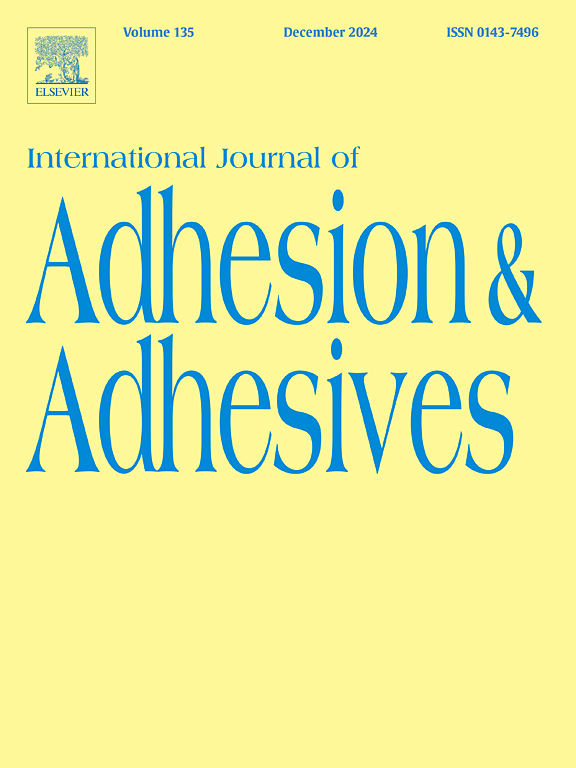Analysis of load-displacement curves of an adhesive-reinforced composite patch repaired plate using the combination of XFEM and CZM techniques
IF 3.5
3区 材料科学
Q2 ENGINEERING, CHEMICAL
International Journal of Adhesion and Adhesives
Pub Date : 2024-11-08
DOI:10.1016/j.ijadhadh.2024.103885
引用次数: 0
Abstract
Since the development of the eXtended Finite Element Method (XFEM), Cohesive Zone Modelling (CZM), and the Virtual Crack Closure Technique (VCCT) for damage analysis in repaired structures, it has now become easy to validate experimental tensile tests carried out on damaged and repaired plates with a composite patch. In most cases, these tensile tests can be expensive and time-consuming due to surface preparation, cleaning, polishing, adhesive application, and the crosslinking time of the adhesive, which must be carefully considered. The analysis of damage in structures assembled by adhesive bonding is crucial to predicting their behavior under various loading conditions. Moreover, the analysis of experimental curves is in most cases translated a global behavior without taking into account the details that can influence the results. With the introduction of techniques (XFEM, CZM and VCCT), it is now possible to model different forms of damage, accounting for several mechanical and geometric parameters of the plate, patch, and adhesive. This work aims to analyze the behavior under tensile loading of a 2024-T3 aluminum plate presenting an initial crack of different lengths emanating from a central circular notch. This plate is repaired by a carbon/epoxy type patch through an adekit A140 adhesive. The combined use of XFEM to track damage in the plate and CZM for adhesive debonding allowed the acquisition of tensile load-elongation curves and the assessment of damage inflicted by loading on the plate. The results demonstrate that the combined use of XFEM and CZM techniques enables the identification of the adhesive debonding impact on the load transfer to the patch and consequently on the strength of the repaired structure. Furthermore, these highlight that the decrease in the effectiveness of the composite patch with increasing crack size is directly linked to the progressive deterioration of both the plate and the adhesive strength.
结合 XFEM 和 CZM 技术分析粘合剂加固复合材料修补板的荷载-位移曲线
自从开发出用于修复结构损伤分析的扩展有限元法 (XFEM)、粘合区建模 (CZM) 和虚拟裂缝闭合技术 (VCCT) 以来,对带有复合材料补丁的受损和修复板材进行拉伸实验验证已变得非常容易。在大多数情况下,由于必须仔细考虑表面准备、清洁、抛光、粘合剂涂抹和粘合剂交联时间等因素,这些拉伸试验既昂贵又耗时。分析通过粘合剂粘接组装的结构的损坏情况对于预测其在各种加载条件下的行为至关重要。此外,在大多数情况下,对实验曲线的分析是对整体行为的翻译,而没有考虑到可能影响结果的细节。随着各种技术(XFEM、CZM 和 VCCT)的引入,现在可以建立不同形式的损坏模型,并考虑板材、贴片和粘合剂的多个机械和几何参数。本研究旨在分析 2024-T3 铝板在拉伸载荷作用下的行为,该铝板的中心圆形缺口处出现了不同长度的初始裂纹。通过 adekit A140 粘合剂对该铝板进行碳/环氧型修补。结合使用 XFEM 跟踪板材损坏情况和 CZM 评估粘合剂脱粘情况,可以获得拉伸载荷-伸长曲线,并对板材加载造成的损坏进行评估。结果表明,结合使用 XFEM 和 CZM 技术,可以确定粘合剂脱粘对荷载传递到补丁的影响,进而对修复结构的强度产生影响。此外,这些结果还突出表明,随着裂缝尺寸的增大,复合材料补片的有效性会降低,这与板和粘合剂强度的逐渐降低直接相关。
本文章由计算机程序翻译,如有差异,请以英文原文为准。
求助全文
约1分钟内获得全文
求助全文
来源期刊

International Journal of Adhesion and Adhesives
工程技术-材料科学:综合
CiteScore
6.90
自引率
8.80%
发文量
200
审稿时长
8.3 months
期刊介绍:
The International Journal of Adhesion and Adhesives draws together the many aspects of the science and technology of adhesive materials, from fundamental research and development work to industrial applications. Subject areas covered include: interfacial interactions, surface chemistry, methods of testing, accumulation of test data on physical and mechanical properties, environmental effects, new adhesive materials, sealants, design of bonded joints, and manufacturing technology.
 求助内容:
求助内容: 应助结果提醒方式:
应助结果提醒方式:


